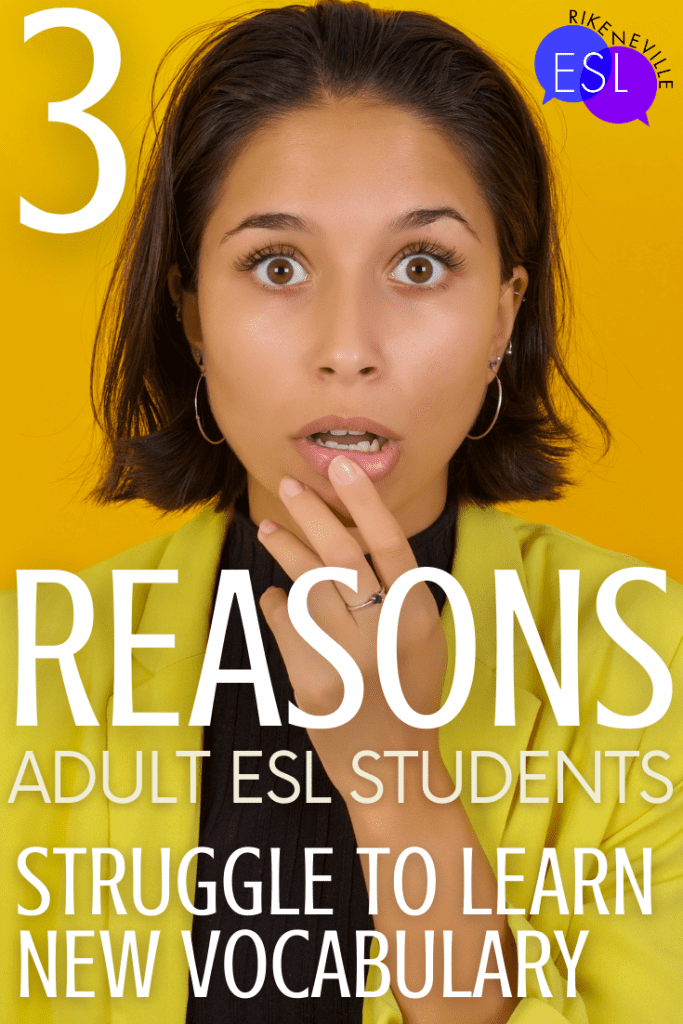
I can give you three reasons your adult ESL students struggle with learning new vocabulary, but let’s not stop there. Let’s talk about some strategies for overcoming these challenges.
First, their go-to strategy is straight-out memorization.
How many times have you spoken to students who are despondent over how few vocabulary words they retain compared to how many they study? I remember Mesfer proudly telling me that he “learned” 30 words PER DAY. That’s 210 words per week! (He never took the weekend off.) Guess what? His greatest strength was not vocabulary.

At that rate, he certainly wasn’t doing much more than trying to memorize the term and a definition. He wasn’t using it in any authentic way, despite the best of intentions. Was this truly learning new vocabulary?
Why isn’t simple repetition enough?
When summing up some studies on repetition, Timothy Shanahan said, “…the number of repetitions needed to learn a word is about 10-15 times…” Perhaps this is what made Teng write vocabulary words 20 times each and believe he then knew the words. However, there is a little more to it. Shanahan also said that a lot of variation is needed.
Variation is where adult ESL books often fall short. There just isn’t that much. The books that do incorporate a variety of exercises fail in another aspect–length. There might be four different exercises, but our students aren’t getting enough practice when each exercise uses only a fraction of the vocabulary words. Students who are learning new vocabulary need to practice all the words in a variety of ways, not just some of them.
Second, the practice for learning new vocabulary is often limited in both variety and scope.
Textbooks can’t reach individual students, and they aren’t meant to. However, if we want our individual students to learn, we need to adapt what the books have to offer. The textbook Saad and Shimin shared lacked what both considered very important: vocabulary exercises. Each unit would present the vocabulary with a little picture, the word, and one short exercise—and that was it. Nothing else. Both students found the lack of available practice frustrating. They were beginners, so going out and immediately using the words in context was too great a challenge for them. Learning new vocabulary in this way happened at a snail’s pace. They both needed a wide assortment of longer exercises.

Here’s how to increase the variety and scope of their vocabulary practice.
Whether you are teaching beginners or advanced learners, be sure to do the following whenever you teach vocabulary.
Teach it within the four language domains.
Exercises that rely on students to read sentences or write sentences without also giving them speaking and listening practice are not enough. Find ways to ensure that your students listen to and for the words, say the words, read the words, and write (level-appropriate) sentences with the words. You get ten gold stars when you make it all in context as well.
Mix the vocabulary into with your grammar lessons.
You know all those example sentences you are constantly coming up with? Tailor them around the vocabulary your students are learning. Add the vocabulary to their fill-in-the-gap sentences. Learning new vocabulary will be easier for them when you give them some level-appropriate grammar structures that make it easy to plug in those words. This lets them practice the vocabulary in context with full sentences.
Use the vocabulary to teach pronunciation.
Chances are, there is a sound or two or ten that your students struggle with. Focus on those sounds with your students.
You want to find ways to insert the vocabulary they are learning into everything you do with your students until the words are embedded in their brains. Never assume that just because they are adults, they’ll acquire the terms with a simple glance.

The third reason is the vocabulary doesn’t interest them.
Okay, so they WILL have to study vocabulary that is of no interest to them. Learning new vocabulary isn’t always going to be fun, either. BUT show them how to make it USEFUL, and they will find learning new vocabulary interesting. Sometimes you can use a set of vocabulary words to help your students accomplish something else that they want. You definitely need to know your students on an individual basis to make this work, but knowing our students is something we tend to make our mission anyway, right?
Here’s how to use the vocabulary to help them reach a goal.
Byung-Jin didn’t want to learn sports vocabulary. He hated sports and planned to major in business. He had zero interest in our sports-themed unit, and he resented having to learn the terms. However, he wanted to improve his spelling. Knowing that, I used the sports vocabulary to show him how to look for spelling patterns. Quite accidentally, he ended up learning most of them just through his spelling studies. He did well on the unit test, but more importantly, he accomplished his goal of improving his spelling.
Meiko also didn’t see a point in learning the sports vocabulary, but she was quite happy to improve her pronunciation using those words. By the time she had nailed some of her pronunciation weaknesses that happened to be some of the sounds in the sports terms and their definitions, she had also learned the words.

Individualizing the paths for learning vocabulary pays off in more than one way.
In fact, all of my students were still learning the required vocabulary. Because I didn’t insist that they all take the same approach, they learned it in a way that was meaningful to them. Incorporating their personal learning goals with learning the vocabulary meant that I could keep the entire class in the same chapter, if not on the same page.
One more thing. Giving my students the means to accomplish one of their own goals also made them willing to participate in the other activities I had for that sports-themed unit. I met them where they were and guided them on a path to their preferred destination, so they worked with me when it was time to have a class discussion on sports, perform a sports-related role-play or even interview a classmate about sports.
Read more about learning new vocabulary for adult ESL!
- Stop Pre-Teaching Vocabulary All the Time!
- Two Engaging Multi-Level Vocabulary Games for Adult ESL
- 2 Powerful Techniques to Increase Student Engagement with Academic Vocabulary Part 1
- How to Increase Student Engagement with Academic Vocabulary Part 2: Using Videos
- 3 FUN Vocabulary Games for Adult ESL

Leave a Reply